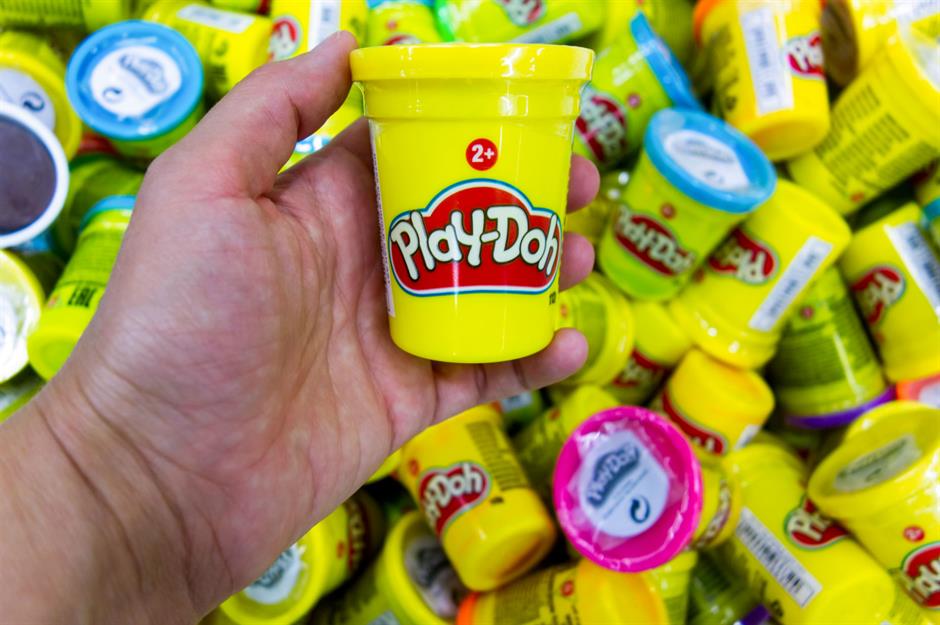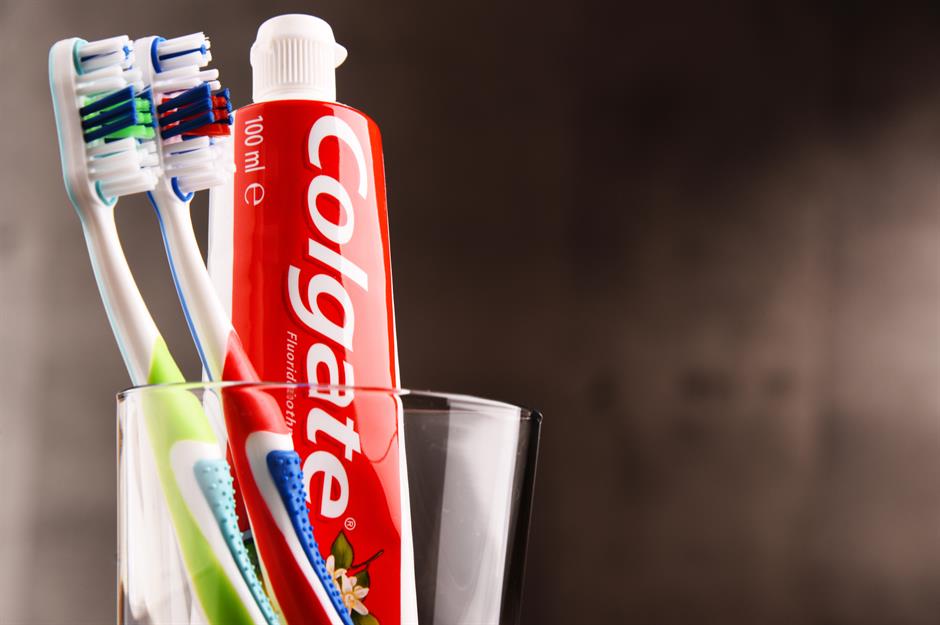Big businesses that dramatically changed course from what they started out doing
Big-name businesses that changed direction
Colgate: now
Colgate: then
American Express: now
American Express: then
Avon: now
Cosmetics company Avon split into two in 2016, with its US, Canadian and Puerto Rican branches becoming New Avon, and the global Avon Products moving headquarters to London. However, despite being a household name the company has struggled in recent years, with shares down 89% in the last five years, to $1.38 (£1.09) at their lowest in 2018.
Avon: then
Around 34 years before US women earned the right to vote, door-to-door book salesman David McConnell (pictured) gave away perfume samples to those who bought books from him – but he quickly realised the perfume was more popular than what he was actually selling. That paved the way for the California Perfume Company, with McConnell recruiting women as his salesforce. In 1929, the Avon name was first used on cosmetics and the company was renamed 10 years later.
Nintendo: now
Nintendo: then
Yet Nintendo was actually founded in 1889 as a maker of handmade playing cards by Fusajiro Yamauchi in Japan's former capital Kyoto. From 1963, when his grandson took over, the company experimented with new business streams, from a taxi company to a hotel chain and even a TV network. It was the creation of Donkey Kong in the early 1980s that cemented Nintendo’s fortune, and future, in video games.
Do you have any of these Christmas presents that are now worth a fortune?
Wrigley: now
Confectioner Mars and super-investor Warren Buffett made a joint $23 billion (£18bn) takeover bid for chewing gum giant Wrigley back in 2008, and Mars bought Buffett out in 2016 to form Mars Wrigley Confectionery. William Wrigley Junior II, the great-grandson of the man behind the original Wrigley brand, has since moved on to medical marijuana company Surterra Wellness. But Wrigley started out in similar fashion to Avon.
Wrigley: then
Wrigley chewing gum started life as a freebie thrown in by William Wrigley Junior (pictured with his wife) with sales of his cans of baking powder and soaps. From 1891, he went on to manufacture his own chewing gum brands – Juicy Fruit, Spearmint and Doublemint – as the free gum proved more popular than the other goods.
Suzuki: now
Suzuki: then
Marriott International: now
Marriott International: then
But the company's history began in a very different field. In 1927, J Willard Marriott and his wife Alice opened their first A&W nine-seat root beer stand in Washington DC, before adding food and renaming the company Hot Shoppes. The historic shift into the hotel business came in 1957 when the couple's son Bill opened the world’s first motor hotel, or motel, in Arlington, Virginia. Over the next 25 years, Marriott became a diverse global enterprise and transformed the hospitality industry. By 1988 it had opened its 500th hotel.
Samsung: now
Samsung: then
However, Samsung Sanghoe started out as a small grocery store opened by Lee Byung-Chull in Taegu, Korea in 1938, exporting dried fish, noodles and vegetables to customers in China. After the Korean War, he expanded into textiles before investing in the petrochemcial industry in the 1970s, which provided a promising foundation. Samsung first ventured into electronics in 1969 with several electronics-focused divisions – its first product being a black and white television.
HP: now
HP: then
But it all started off in audio equipment. This picture shows Hewlett-Packard company co-founders David Packard (seated) and William Hewlett running final production tests on a shipment of the 200A audio oscillator. It was taken in 1939 in the garage at 367 Addison Avenue, Palo Alto, California where they began their business, and it is still headquartered in the city today.
Lamborghini Trattori: now
Lamborghini Trattori: then
Before going into supercars, Ferruccio Lamborghini first created Lamborghini Trattori in 1948 – a tractor company so successful it still exists today. Ferruccio first built a tractor for his farmer father (and later his father's friends) to use in post-war Italy, where argiculture had been ruined. But as his designs evolved, it was cars that he really wanted to focus on and he built his first in the early 1960s.
Check out these 25 massive companies that are still family owned
Gap: now
Gap: then
Gap started life in 1969 as a shop selling records and tapes alongside jeans. Owner Donald Fisher aimed the goods at ‘the generation gap’. The records were soon ditched and Fisher focused on denim. He and his wife Doris opened five further stores within a year, going public the year after and creating the Gap jean brand in 1973 after he couldn't find a pair of jeans to fit him correctly.
Berkshire Hathaway: now
Berkshire Hathaway: then
But far from the multinational giant we know today, Berkshire Hathaway was originally formed by a merger of cotton mill Hathaway Manufacturing Company (established in 1888 by whaler Horatio Hathaway) and Berkshire Fine Spinning Associates (formed by the merger of four textile companies in 1929 and owned by Seabury Stanton) in 1955. The new company had over 10,000 employees and around $120 million (equivalent to $1.1bn/£874m today) in revenue but began to falter due to falling cotton prices. Buffett shut down its last mill in 1985 to focus on more lucrative business options, which certainly paid off.
It wasn't all rosy for Buffett though. Discover his and other Billionaires' biggest business blunders ever
Twitter: now
Social media platform Twitter floated in 2013 and posted revenues of $758 million (£598m) in the third quarter of 2018, up 29% in year-on-year.
Discover the 15 companies that boomed in 2018 and 15 that tanked
Twitter: then
But before a world of opinions in 280 characters (up from its original 140-character limit), Twitter originally started life as a side-project by staff at Odeo, which was a podcast subscription network quickly overshadowed by iTunes. When it was clear the business needed an alternative, this new micro-blogging platform became the focus and entered the world in 2006. Image courtesy of The Internet Archive Wayback Machine
IBM: now
IBM got out of the personal computer business in 2005 and the server business in 2014, selling both to Lenovo. In 2011, the year it turned 100, its artificial intelligence programme Watson beat two human champions in TV show Jeopardy. It is now pushing ahead with consulting and IT services such as cybersecurity, data analytics and cloud computing and is valued at $132.3 billion (£105bn).
IBM: then
IBM actually started out as the Computing-Tabulating-Recording (CTR) company in 1911 and was renamed International Business Machines in 1924, producing punch card tabulating machines. It wasnt until 1953 that it introduced its first computer, the 701 (pictured). The 701 carried out 17,000 instructions per second and was initially used for government and research work.
Play-Doh: now
Believe it or not, toy maker Hasbro has recently trademarked Play-Doh’s smell – “sweet, slightly musky”, vanilla, cherry, with the smell of a “salted, wheat-based dough”, in case you were wondering. It bought the mouldable clay as part of its acquisition of Tonka in 1991 and Hasbro says it produces 500 million cans of Play-Doh each year.
Discover 25 of the craziest copyright claims
Play-Doh: then
However, Play-Doh started off as a wallpaper cleaner created by failing Cincinnati soap company Kutol in 1956. The non-toxic, malleable clay-like compound saved Kutol for another 20 years at least. As sales in wallpaper cleaner plummeted, the product was reimagined by its owners as a children’s toy, thanks to a family member taking it into the nursery where she worked to make Christmas decorations. Children loved it, so it was reformulated and repurposed and first sold as an off-white dough before the infamous red, yellow and blue dyes were added. The rest, as the saying goes, is history.
Now discover The 50 companies that rule the world

